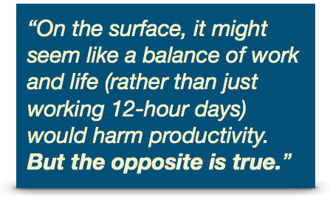 Over the past month, we’ve been addressing the issue of burnout here on The Wireboard. We’ve looked at some of the symptoms of burnout as well as productive responses to address it. We’ve shared stories about professionals in the midst of burnout as well as those who’ve successfully come back from being burned-out.
Over the past month, we’ve been addressing the issue of burnout here on The Wireboard. We’ve looked at some of the symptoms of burnout as well as productive responses to address it. We’ve shared stories about professionals in the midst of burnout as well as those who’ve successfully come back from being burned-out.
In this week’s post, we’re going to start to pivot to a related trait that comes up again and again in the literature on burnout. On the positive side, this trait seems to predict better productivity and job satisfaction, while the lack of this trait signals the burnout we’ve been discussing for the last month.
What is this trait that predicts and connects burnout, job satisfaction and productivity all at once?
Work-life balance.
But, in order to understand the impact of work-life balance on these crucial dynamics, we’ll need to start with stressed-out healthcare workers.
Can a doctor get a break?!
Much of the pioneering work on the topic of burnout came from studying healthcare workers. One of the first researchers to use the term “burnout” as we understand it today was Herbert Freudenberger. When he first started working at a drug treatment clinic in New York, he was passionate about using his medical expertise to help those suffering from addiction. But over time, both he and his colleagues began to experience the symptoms we’ve been discussing in previous posts. And the term he chose to describe this cluster of symptoms was burnout.
 His work was picked up by other researchers who were looking for a way to measure the symptoms of burnout in order to assess whether an individual was suffering from it. Christina Maslach, Susan Jackson and Michael Leiter looked at three main traits of burnout and then developed the Maslach Burnout Inventory as a way to measure it. And what was one of the first populations they used to test the ability of their assessment to identify working people headed for burnout?
His work was picked up by other researchers who were looking for a way to measure the symptoms of burnout in order to assess whether an individual was suffering from it. Christina Maslach, Susan Jackson and Michael Leiter looked at three main traits of burnout and then developed the Maslach Burnout Inventory as a way to measure it. And what was one of the first populations they used to test the ability of their assessment to identify working people headed for burnout?
You guessed it: healthcare workers.
Intuitively, it makes sense that the idea of burnout would arise from the medical profession. Every day, these professionals are presented with an endless supply of problems to solve; each problem requiring critical thinking skills; each problem connected to a real person in distress of some sort, with potentially massive consequences for both inaction and failure.
Burnout and work-life balance go mainstream, with important insights
Thankfully, our knowledge regarding burnout has spread beyond the healthcare profession to address most anyone who works with other people. And that same Maslach Burnout Inventory I mentioned earlier has been adapted and tested to work with individuals across a broad range of industries. More importantly, we have a greater understanding of burnout’s relationship to other personal traits that affect a person's work:
- Age
- Sex
- Length of tenure
- Average amount of sleep
- Number of hours worked per week
- Personality traits
- Productivity
- Job satisfaction
- Work-life balance
These are just a few of the traits that have connections to the issue of burnout, but I want to end this piece focusing on those last few: productivity, job satisfaction, and work-life balance (which I’m defining as the ability to meaningfully choose between work-related and personal-related activities with adequate time devoted to each).
Based on the research, what we see is that work-life balance operates as a powerful force to increase productivity and job satisfaction while decreasing burnout symptoms. On the surface, it might seem like a balance of work and life (rather than just working 12-hour days) would harm productivity. But the opposite is true.
Similarly, we might think that carving out space for a solid balance of work and personal life would cause us to feel less satisfied with the work we do. But again, the opposite is true.
 Take this study of IT professionals, researchers which discovered that individuals with a healthy work-life balance were more satisfied with the work they were doing. That study also confirms that individuals reporting a healthy work-life balance were also less likely to display symptoms of burnout. And if we go back to our friends in the healthcare industry, we find that work-life balance is one of the strongest predictors of either job satisfaction or burnout.
Take this study of IT professionals, researchers which discovered that individuals with a healthy work-life balance were more satisfied with the work they were doing. That study also confirms that individuals reporting a healthy work-life balance were also less likely to display symptoms of burnout. And if we go back to our friends in the healthcare industry, we find that work-life balance is one of the strongest predictors of either job satisfaction or burnout.
So, if we put it all together, work-life balance doesn’t harm our productivity or our satisfaction with our work. It improves both! And it does so while acting as a preventative against the harmful symptoms of burnout.
In upcoming posts, we’ll dive deeper into work-life balance: what it looks like, what it doesn’t look like, the unique challenges faced by women navigating work-life balance, and concrete strategies for establishing (or reclaiming) work-life balance.
In the meantime, take a look at some of the studies I referenced for more specifics. And you can start improving work-life balance with this free guide we've created to help you assess where you are doing well and what parts of your life may need more attention. Just click below to access it.



